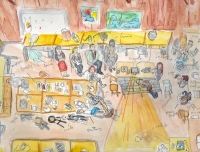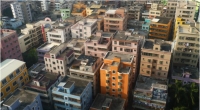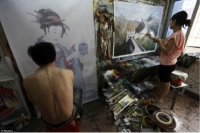Art+Village+City: On the Photograph
Art+Village+City in the Pearl River Delta is one of two interdisciplinary courses being sponsored by the Global Urban Humanities Initiative in Spring 2015. Students in this research studio are utilizing a variety of research methods from interviews to video documentation to explore the ongoing evolution of relationships between urban and rural spaces and people, and the emerging role of the arts in China’s Pearl River Delta.
This week in the studio we worked on two common forms of fieldwork representation that are often overlooked: the single photograph, and the anecdote. Each student took a single photograph and told a single anecdote. In our studio crit, we reflected upon what an anecdote or a photograph can and cannot do as a form of research representation. At issue are questions of narrative and image, both in our own making of images and anecdotes, and in our framing and telling of them.
— Winnie Wong
“As I thought about what I might want to photograph I was constantly reminded of what I perceive to be my inability to capture the perfect photo while I am in the field or to determine what might be ‘interesting.’ It was with this in mind that I chose to use a photograph of the San Francisco skyline taken from Sausalito. As I mentioned in class, this is a photograph I have taken on numerous occasions. Each time, while from the same spot, the image of San Francisco appears different. While this is not a profound reflection I think that it demonstrates the relevance of how something is represented based on when a picture is taken, who takes the picture, and how it is later presented be it with captions or not.”
— Katie Bruhn (Southeast Asian Studies)
“We are very used to being faced with anonymous images, and while I’m not sure that we mistake them as objective, we do not (could not possibly) analyze each one in the way that we did this project…it was a pleasure to take time with images, digesting them aesthetically and probing them for meaning. It gave them back the dignity that has been taken away by the digital proliferation of photographs. We assign meaning by choosing a single photograph and by giving it a caption or not, and others assign meaning by seeing it from their unique perspective. It’s a fascinating process and undervalued or taken for granted today.“
— Story Wiggins (Landscape Architecture)
“What does it mean to represent versus narrate? Although one may instinctively argue that narration is typically performed through word and representation through image, I think that these divisions were blurred a lot on Tuesday. Therefore, for my own purpose within the class, it became clear to me that I need to move beyond just picking any story or image without some sort of minimal thought into our own motives or interests in taking that picture or selecting that story. Even if I am to use photography more as a from of documentation than a narration of a particular moment, I need to then locate that series of photos within a broader framework of motives, aims, and questions that they then help evoke."
- Trude Renwick (Architecture)
“What struck me about the presentation of photos was the number of ways photos could be interpreted or talked about. Having a range of visual languages within the class (architects, urban planning, design, art practice, anthropology, art history, etc.), it was clear that different people saw different things when viewing the photographs.”
— Brittany Birberick (Anthropology)
“With a studio art background, I am much more comfortable composing visual rather than verbal communications. However, to help make sense of what my image was showing, I had to provide quite a bit of verbal explanation about what the objects in my photo were…. I was impressed by the range of approaches the class took in capturing, captioning and composing their photos. Story’s caption, Sben’s croppings, Susan’s referential process, Xiuxian’s sequencing, Brittany’s accidental symbolism, and José’s layers of bizarre-ness were most notable to me and I think the photos presented may very well tell more about the people who took them than the subjects or objects within them.”
— Genise Choy (City Planning)
“I was struck by the effectiveness of some of the pictures to convey a story, especially Story’s “Leather harvest”. It was interesting to see that the class’ photographs presented a wide range of approaches: some were anecdotes, other registered scenes, while others were aesthetic compositions. Further, the relationship between text and image acquired multiple dimensions: some pictures were in dialect with their caption; others had no caption, and some had a description.”
— Valentina Rozas Kraus (Architecture)
“While I thought [my photo] was very funny, I realized in class how different my classmates understood it. It stuck me that photograph could be culturally exclusive to the others. The way I understood and felt about the photo is tightly related to my cultural background. Without explanation, this photo is totally another thing to the people from other background. Here is my question, photo as visual medium, can it communicate effectively? Can it be narrative?"
— Xiuxian Zhan (Landscape Architecture)
“When I showed my photograph several things became apparent which I had not thought about. I wrote a caption about the postures of the people, which really struck me—the woman’s formal portrait stance and the man lunging to capture her. The class seemed less interested in these poses and more interested in the angles—the strong diagonal line, the accuracy of the caption—how did I know they were tourists?—as well as the fact that I failed to capture the site in front of which the woman posed. We presume tourists aim to record the act of being in a particular place, so why did I not take the photograph from an angle at which I could see that place? It hadn’t occurred to me because I was caught up in their relation…”
— Annie Malcolm (Anthropology)
“Annie presented an ethnographic image, for example, that she coded as such through the caption and her explanation. Can we read her image as data about a cultural actor or practice? Or does her framing of the scene—the strong diagonals echoing the diagonal positions of the two standing figures—already determine its status as a photograph taken by someone who is making the photo by following certain compositional conventions, therefore giving it a connotative, aesthetic value that exceeds its denotative ethnographic content? …Sben took the opposite approach: he shot many pictures of a place before deciding on one to share with us—based on a data-mining procedure he produced after-the-fact. Instead of centralizing the figures like in Annie’s photo or in history painting, his figures were diffuse, more like a Dutch landscape or genre scene showing a literal slice-of-life, in Svetlana Albers’ reading, the real “as it is.” With technologically-aided enhancement, he was able to zoom in on his photograph to reveal more than is initially visible to both the human eye and attention span. Though by fracturing the photo into mini-dramas, we lose the glossy perfection of the intact whole, the picture-postcard.”
— Susan Eberhard (Art History)
Art+Village+City: Video Presentations
 Art+Village+City in the Pearl River Delta is one of two interdisciplinary courses being sponsored by the Global Urban Humanities Initiative in Spring 2015. Students in this research studio are utilizing a variety of research methods from interviews to video documentation to explore the ongoing evolution of relationships between urban and rural spaces and people, and the emerging role of the arts in China’s Pearl River Delta. Students paired up to create videos of places related to China and the Chinese diaspora throughout the Bay Area. Here is José Figueroa's watercolor documentation of the in-class presentations! We'll be posting one of…
Art+Village+City in the Pearl River Delta is one of two interdisciplinary courses being sponsored by the Global Urban Humanities Initiative in Spring 2015. Students in this research studio are utilizing a variety of research methods from interviews to video documentation to explore the ongoing evolution of relationships between urban and rural spaces and people, and the emerging role of the arts in China’s Pearl River Delta. Students paired up to create videos of places related to China and the Chinese diaspora throughout the Bay Area. Here is José Figueroa's watercolor documentation of the in-class presentations! We'll be posting one of…
Opportunities to Create an Inclusive Sense of Place
 As part of the Global Urban Humanities Initiative Colloquium called Reading Cities, Sensing Cities we have asked students and visitors to write responses to each of the weekly guest lectures. November 6, 2014 The Art of Change: Exploring Neighborhoods in Transition Sue Mark (marksearch) and Anisha Gade (City and Regional Planning and Architecture) Presentation available here. Video of the conversation available here. Mark and Gade discussed their project, Communities’ Crossing, a creative placemaking effort along San Pablo Avenue. by Yasir Hameed During Sue Mark and Anisha Gade’s presentation, it was stated that it is not possible for planners to create…
As part of the Global Urban Humanities Initiative Colloquium called Reading Cities, Sensing Cities we have asked students and visitors to write responses to each of the weekly guest lectures. November 6, 2014 The Art of Change: Exploring Neighborhoods in Transition Sue Mark (marksearch) and Anisha Gade (City and Regional Planning and Architecture) Presentation available here. Video of the conversation available here. Mark and Gade discussed their project, Communities’ Crossing, a creative placemaking effort along San Pablo Avenue. by Yasir Hameed During Sue Mark and Anisha Gade’s presentation, it was stated that it is not possible for planners to create…
Exploring Neighborhood Boundaries and Transforming Community
 As part of the Global Urban Humanities Initiative Colloquium called Reading Cities, Sensing Cities we have asked students and visitors to write responses to each of the weekly guest lectures. November 6, 2014 The Art of Change: Exploring Neighborhoods in Transition Sue Mark (marksearch) and Anisha Gade (City and Regional Planning and Architecture) Presentation available here. Video of the conversation available here. Mark and Gade discussed their project, Communities’ Crossing, a creative placemaking effort along San Pablo Avenue. by Yuqing Nie Last week, artist Sue Mark and urban planner/design researcher Anisha Gade gave a talk on their latest creative place-making…
As part of the Global Urban Humanities Initiative Colloquium called Reading Cities, Sensing Cities we have asked students and visitors to write responses to each of the weekly guest lectures. November 6, 2014 The Art of Change: Exploring Neighborhoods in Transition Sue Mark (marksearch) and Anisha Gade (City and Regional Planning and Architecture) Presentation available here. Video of the conversation available here. Mark and Gade discussed their project, Communities’ Crossing, a creative placemaking effort along San Pablo Avenue. by Yuqing Nie Last week, artist Sue Mark and urban planner/design researcher Anisha Gade gave a talk on their latest creative place-making…
Living Archives: Filling Silences in History
 As part of the Global Urban Humanities Initiative Colloquium called Reading Cities, Sensing Cities we have asked students and visitors to write responses to each of the weekly guest lectures. November 6, 2014 The Art of Change: Exploring Neighborhoods in Transition Sue Mark (marksearch) and Anisha Gade (City and Regional Planning and Architecture) Presentation available here. Video of the conversation available here. Mark and Gade discussed their project, Communities’ Crossing, a creative placemaking effort along San Pablo Avenue. by Jaime Gómez The tons of documents hidden in Archives with a capital “A” around the world and managed by public and…
As part of the Global Urban Humanities Initiative Colloquium called Reading Cities, Sensing Cities we have asked students and visitors to write responses to each of the weekly guest lectures. November 6, 2014 The Art of Change: Exploring Neighborhoods in Transition Sue Mark (marksearch) and Anisha Gade (City and Regional Planning and Architecture) Presentation available here. Video of the conversation available here. Mark and Gade discussed their project, Communities’ Crossing, a creative placemaking effort along San Pablo Avenue. by Jaime Gómez The tons of documents hidden in Archives with a capital “A” around the world and managed by public and…
Urban Ap(ART)heid: Who and Who Defines Citizenship?
 As part of the Global Urban Humanities Initiative Colloquium called Reading Cities, Sensing Cities we have asked students and visitors to write responses to each of the weekly guest lectures. October 2, 2014 Experiments in Online and Print Journals on Cities: Urban Pilgrimage and pARTicipatory Urbanisms Padma Maitland (Architecture and South and Southeast Asian Studies), Lawrence Yang (East Asian Languages and Cultures), Karin Shankar (Performance Studies), and Kirsten Larson (City and Regional Planning and Architecture) Presentations available here. Video of the conversation available here. Padma, Lawrence, Karin, and Kirsten shared reflections on their research and the process of curating their…
As part of the Global Urban Humanities Initiative Colloquium called Reading Cities, Sensing Cities we have asked students and visitors to write responses to each of the weekly guest lectures. October 2, 2014 Experiments in Online and Print Journals on Cities: Urban Pilgrimage and pARTicipatory Urbanisms Padma Maitland (Architecture and South and Southeast Asian Studies), Lawrence Yang (East Asian Languages and Cultures), Karin Shankar (Performance Studies), and Kirsten Larson (City and Regional Planning and Architecture) Presentations available here. Video of the conversation available here. Padma, Lawrence, Karin, and Kirsten shared reflections on their research and the process of curating their…
Publications of Access and Agency
 As part of the Global Urban Humanities Initiative Colloquium called Reading Cities, Sensing Cities we have asked students and visitors to write responses to each of the weekly guest lectures. October 2, 2014 Experiments in Online and Print Journals on Cities: Urban Pilgrimage and pARTicipatory Urbanisms Padma Maitland (Architecture and South and Southeast Asian Studies), Lawrence Yang (East Asian Languages and Cultures), Karin Shankar (Performance Studies), and Kirsten Larson (City and Regional Planning and Architecture) Presentations available here. Video of the conversation available here. Padma, Lawrence, Karin, and Kirsten shared reflections on their research and the process of curating their…
As part of the Global Urban Humanities Initiative Colloquium called Reading Cities, Sensing Cities we have asked students and visitors to write responses to each of the weekly guest lectures. October 2, 2014 Experiments in Online and Print Journals on Cities: Urban Pilgrimage and pARTicipatory Urbanisms Padma Maitland (Architecture and South and Southeast Asian Studies), Lawrence Yang (East Asian Languages and Cultures), Karin Shankar (Performance Studies), and Kirsten Larson (City and Regional Planning and Architecture) Presentations available here. Video of the conversation available here. Padma, Lawrence, Karin, and Kirsten shared reflections on their research and the process of curating their…
Thoughts on Urban Villages by a Native of Guanghzhou
 As part of the Global Urban Humanities Initiative Colloquium called Reading Cities, Sensing Cities, we have asked students and visitors to write responses to each of the weekly guest lectures. On August 28, 2014, Prof. Margaret Crawford (Architecture) gave a presentation on her continuing research on urban villages in the Pearl River Delta—independent jurisdictions that are being swallowed up physically and administratively by large cities. Along with Asst. Prof. Winnie Wong (Rhetoric), she will be teaching a studio course on the Pearl River Delta in Spring 2015. Her presentation is available here. Video of the first portion of her presentation is available…
As part of the Global Urban Humanities Initiative Colloquium called Reading Cities, Sensing Cities, we have asked students and visitors to write responses to each of the weekly guest lectures. On August 28, 2014, Prof. Margaret Crawford (Architecture) gave a presentation on her continuing research on urban villages in the Pearl River Delta—independent jurisdictions that are being swallowed up physically and administratively by large cities. Along with Asst. Prof. Winnie Wong (Rhetoric), she will be teaching a studio course on the Pearl River Delta in Spring 2015. Her presentation is available here. Video of the first portion of her presentation is available…
Questions of Autonomy in Guangdong Urban Art Villages
 As part of the Global Urban Humanities Initiative Colloquium called Reading Cities, Sensing Cities, we have asked students and visitors to write responses to each of the weekly guest lectures. On August 28, Prof. Margaret Crawford (Architecture) gave a presentation on her continuing research on urban villages in the Pearl River Delta--independent jurisdictions that are being swallowed up physically and administratively by large cities. Along with Asst. Prof. Winnie Wong (Rhetoric), she will be teaching a studio course on the Pearl River Delta in Spring 2015. Her presentation is available here. Video of the first portion of her presentation is available here. By…
As part of the Global Urban Humanities Initiative Colloquium called Reading Cities, Sensing Cities, we have asked students and visitors to write responses to each of the weekly guest lectures. On August 28, Prof. Margaret Crawford (Architecture) gave a presentation on her continuing research on urban villages in the Pearl River Delta--independent jurisdictions that are being swallowed up physically and administratively by large cities. Along with Asst. Prof. Winnie Wong (Rhetoric), she will be teaching a studio course on the Pearl River Delta in Spring 2015. Her presentation is available here. Video of the first portion of her presentation is available here. By…




